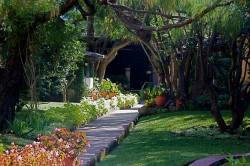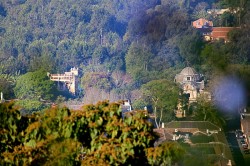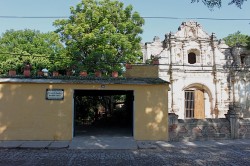The school is situated next to the ruins of the chapel of San Jose el Viejo (3 blocks away from the Central Plaza of Antigua). The school building, used to be part of the church.
The Chapel of San Jose el Viejo
Around 1736 a modest chapel was begun in the Tortuguero District of Antigua. It was intended to house the splendid statue of Saint Joseph, which was the work of the great sculptor Alonso de la Paz. The little hermitage became the house of worship of the needy people of this populous district.
Because of their ignorance, the people did not get the King of Spain’s permission before construction began. The request was made in 1742. Because the law had not been followed, His Majesty ordered the church closed in 1744. In 1745, a new request was sent to the King, which explained the need for the church by the citizens of this community. Eventually, the necessary approval was obtained and the chapel reopened. There is no definite date of the reopening of the church, but it is reported that San Jose el Viejo was damaged in the earthquake of 1751. The building of a more spacious church was undertaken, but the lack of funds caused the work to proceed very slowly. It was not completed until 1761 and Dedication occurred in February, 1762.
Consciousness of earthquakes is apparent in the construction of San Jose el Viejo. The walls are relatively low for the proportions of the church and they are heavily buttressed. The details of the facade are not consistent, or even orthodox, but the general baroque effect is not unpleasant. The single nave is very well lighted and has more architectural merit than the facade.
 Earthquake of 1773
Earthquake of 1773
The building was irreparably damaged during the earthquake of 1773. Until Antigua was made a National Monument in 1944, San Jose el Viejo was used as a barn for the adjacent farm (now the school). It still remains in better condition than most of the churches that experienced the earthquakes of 1762, 1773 and those that ocurred during nearly two centuries since the destruction of Antigua.


